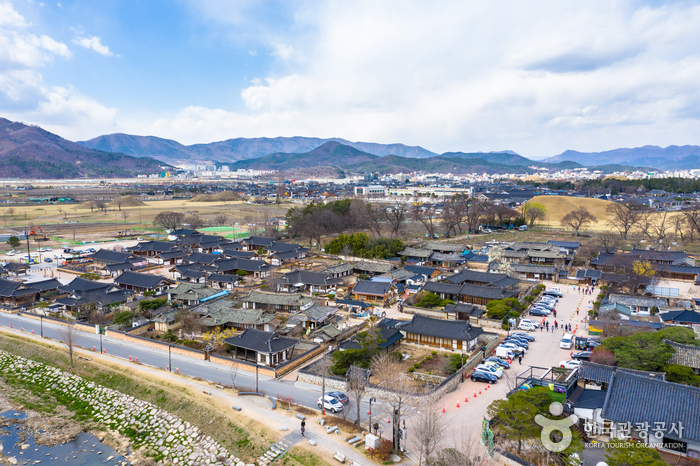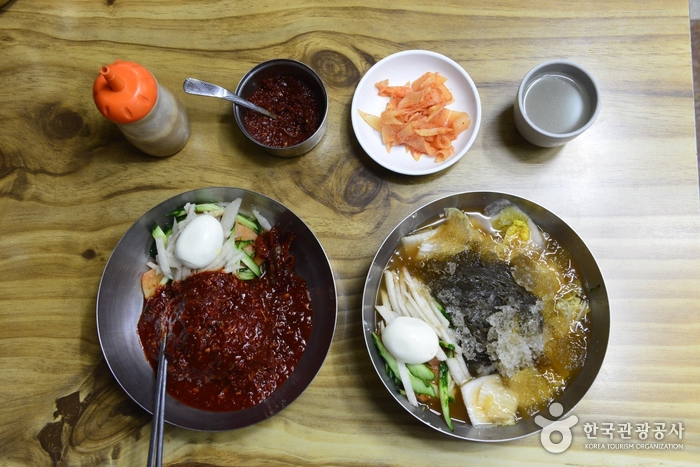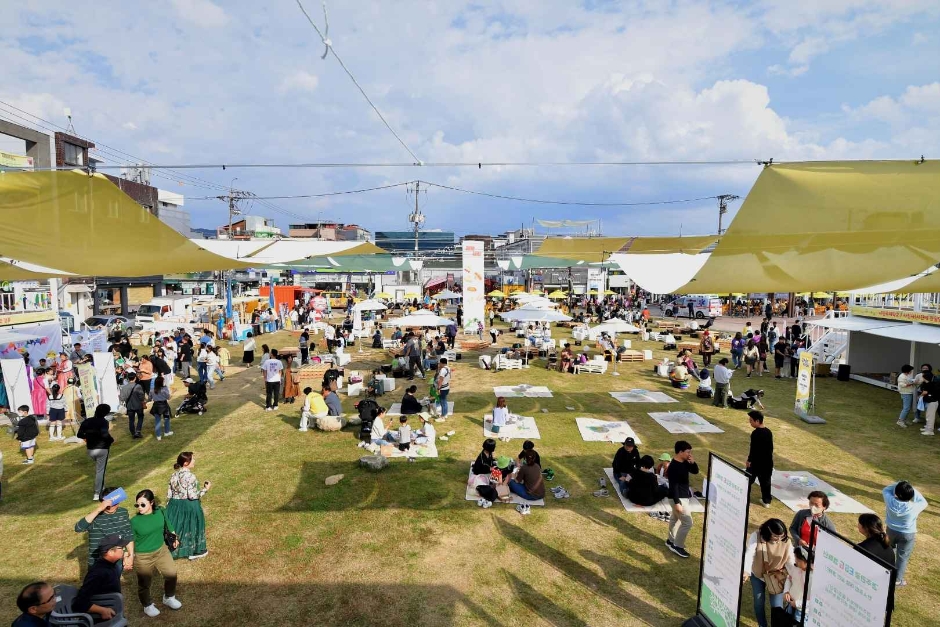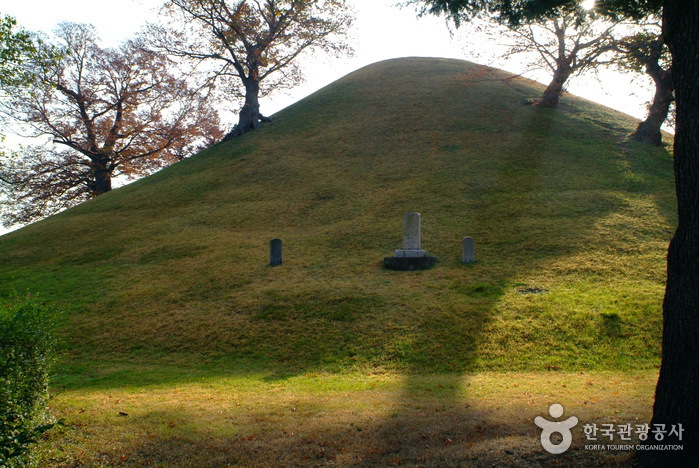Yosokkoong (요석궁)
609.1M 2020-07-14
19-4, Gyochonan-gil, Gyeongju-si, Gyeongsangbuk-do
+82-54-772-3347
Named after Silla King Muyeol's daughter, Princess Yoseok, Yosokkoong serves traditional Korean food. The resturant is run by the Choi family, who settled on the site of Princess Yoseok's house during the Joseon dynasty, and has passed on the restaurant and family recipes through 12 generations. All the foods served are made with organic ingredients, for a healthy taste that cannot be found anywhere else.
Hwarang Guesthouse [Korea Quality] / 화랑게스트하우스[한국관광 품질인증]
634.5M 2023-04-13
136-1, Wonhyo-ro, Gyeongju-si, Gyeongsangbuk-do
+82-10-2473-8329
Hwarang Hostel is located near Daereungwon in Gyeongju.
The three-story guest house has ten rooms in all, and there are two types of rooms - double and quad. Every room is equipped with exclusive toilet and bathroom for the user’s convenience.
The atmosphere of the lobby on the first floor is very relaxing and cozy, furnished with various kinds of books including travel guides.
Communal PC and fax, refrigerator, and washing facility are available. Daereungwon ancient tombs, Cheomseongdae observatory, and Donggung & Wolji palace site are within walking distance from the guest house.
Hwarang Hostel boasts of the best location considering the transportation and tourist destinations. You can also rent a bike for 7,000 won a day.
141MINIHOTEL [Korea Quality] / 141미니호텔 [한국관광 품질인증]
682.0M 2020-09-10
141, Wonhyo-ro, Gyeongju-si, Gyeongsangbuk-do
+82-10-9031-1628
'Located in Gyeongju, the capital of Silla Kingdom for 992 years, 141 Mini Hotel lets you enjoy hotel services at motel room rates. It has sauna, book café, small conference room, and business center for the convenience of its guests. The hotel staff are friendly as well. It's very conveniently located, since it's only 5 minutes away from Gyeongju Station and 10 minutes away from the Bus Terminal, both on foot. There are many popular tourist destinations in the vicinity of the hotel, including Donggung Palace, Wolji Pond, Cheomseongdae Observatory, and Bulguksa Temple.
Aldea Tradicional Gyochon en Gyeongju (경주 교촌마을)
705.0M 2020-10-12
Gyochon-gil 39-2, Gyeongju-si, Gyeongsangbuk-do.
+82-54-760-7880
Situada en la ciudad de Gyeongju, la Aldea Gyeochon es un pueblo de casas tradicionales hanok que permite a los visitantes ver la vida del famoso clan Choi. Los visitantes pueden ver su casa y probar el licor Beopgju Gyodong de Gyeongju.
Pyeongyang Naengmyeon (평양냉면)
740.8M 2017-01-19
109-2, Wonhyo-ro, Gyeongju-si, Gyeongsangbuk-do
+82-54-772-2448
The restaurant of Pyeongyang Naengmyeon has been operated through two generations and thus is very famous in Gyeongju. Its noodles are hand-made from starch of Korea-grown buckwheat and potato and broth is made by deeply boiling beef bones. So, noodles are chewy and broth tastes rich and clean.
Festival de la Cultura de Silla (신라문화제)
746.0M 2024-07-08
Nodong-dong 261, Gyeongju-si, Gyeongsangbuk-do
054-777-6782
Desde 1962, el Festival de la Cultura de Silla ha sido una celebración cultural significativa realizada en el Parque Hwangseong, y el centro de la ciudad de Gyeongju. Es un festival cultural que convoca al espíritu del antiguo reino de Silla, que supo tener una destacada historia y cultura. También presenta la visión de Gyeongju de ser un espacio de intercambio cultural y turismo. El festival les permite a los residentes y turistas unirse bajo un ambiente de interacción positiva, expandiendo asimismo la imagen de Gyeongju como sitio histórico y destino turístico cultural con una herencia milenaria.
Hwangnamguan [Korea Quality] / 주식회사 황남관 [한국관광 품질인증]
746.8M 2023-04-13
1038, Poseok-ro, Gyeongju-si, Gyeongsangbuk-do
+82-10-3518-4582
Located in Gyeongju City, Hwangnamgwan is a traditional Korean style accommodation which opened in April 2014. The place looks like a small hanok village with 4 one-story buildings and 2 two-story buildings, constructed on about 5000㎡ of building site. The buildings are equipped with modern convenience facilities but manage to preserve the antique flavor of traditional Korean house. All rooms are equipped with a bathroom. A bathtub is installed in the largest room, Numaru Suite. Auxiliary facilities include the seminar room which is located in the two-story building. There are a cafe and a pizza restaurant on the first floor for meetings or simple meals. Guests are given discount coupons for the cafe.
Various traditional plays can be enjoyed in the hanok. It is possible to take photos with the beautiful Hwangnamgwan building in the background wearing traditional Korean clothes. You can also play Neolttwigi, Tuho, and Jegichagi in the wide yard and experience twisting legs, bastinado, turning the millstone, fulling, Pogurak (dancing play), etc. which have appeared on TV dramas. It is possible to receive discounted services at nearby affiliated facilities: 50% discount at Spalux Jjimjilbang, Kids Cafe, and Sport Town Bowling Center. Famous tourist attractions such as Cheonmachong Tomb, Cheomseongdae Observatory, and Banwolseong Fortress are within walking distance; and the National Gyeongju Museum and Gyeongju World Culture Expo Park are likewise not far from Hwangnamgwan.
Gyeongju Soohojeong [Korea Quality] / 경주수호정 [한국관광 품질인증]
756.0M 2020-09-08
15-15, Poseok-ro 1068beon-gil, Gyeongju-si, Gyeongsangbuk-do
+82-10-2379-7248
Gyeongju Suhojeong, located in front of the Gyeongju Daereungwon, is a Hanok guesthouse in a ㄱ shape. The traditional house was built in 2015 in accordance with traditional architecture using natural materials such as pine tree, red clay, straw, and others; thus, it is cool in summer and warm in winter. Planted along the wall next to the door are Korean hornbeams, top trees, maple trees, and elm trees. The climbing roses on the wall bloom in May and offer a great sight. The spacious yard with a stone table is a great place to chat with fellow guests. There are seven rooms in total and a cafeteria which doubles as a lounge. Each room with a bathroom has modern facilities that suit traditional beauty. Gyeongju Station and Gyeongju Intercity Bus Terminal are only five minutes away on foot, making the trip to the guesthouse by public transport easy. Sitting right next to the Hwangridangil Street, the accommodation offers great access to popular restaurants and fashion places of Gyeongju, and to major tourist attractions such as Daereungwon, Cheomseongdae, Balwolseong, Anjapji, and Gyochon Village.
Puente Woljeonggyo (월정교)
771.0M 2024-10-08
Gyo-dong 274, Gyeongju-si, Gyeongsangbuk-do
Tumba Geumgwanchong (금관총)
781.7M 2021-05-18
Noseo-dong, Gyeongju-si, Gyeongsangbuk-do
Geumgwanchong se ubica en Noseo-dong, Gwangju, y es una tumba de la dinastía de Silla (a.C 57 a d.C 935). Es una de las tres tumbas del centro de Gwangju que pertenece al distrito de Noseo-dong. No se conoce con certeza, pero se cree que la tumba Geumgwanchon pertenece al cuerpo de un rey anterior o posterior al rey Ji-Jeung a principios del siglo VI. Fue descubierta en septiembre de 1921 cuando el se estaban allanando las tierras para expandir la superficie. La primera reliquia que se encontró en esta tumba es una corona de oro (que en coreano se dice “geumgwan”), que le dio su nombre. También se econtraron en esta tumba ornamentos como cintos de oro, aros, pulseras, accesorios y vajilla de la época de los Tres Reinos (cuando Goguryeo, Baekje, y Silla se separaron para luego unificarse en Silla en 676 d.C). Se encontraron numerosas reliquias, más de 30.000 solo contando los accesorios. La estructura original de Geumgwanchong era de 13 metros de alto y 50 metros de diámetro. Las reliquias de esta tumba fueron transferidas y se preservan en el Museo Nacional de Gyeongju.
![141MINIHOTEL [Korea Quality] / 141미니호텔 [한국관광 품질인증]](http://tong.visitkorea.or.kr/cms/resource/21/2577221_image2_1.jpg)



![Hwangnamguan [Korea Quality] / 주식회사 황남관 [한국관광 품질인증]](http://tong.visitkorea.or.kr/cms/resource/06/2635706_image2_1.jpg)
![Gyeongju Soohojeong [Korea Quality] / 경주수호정 [한국관광 품질인증]](http://tong.visitkorea.or.kr/cms/resource/11/2635611_image2_1.jpg)


 Español
Español
 한국어
한국어 English
English 日本語
日本語 中文(简体)
中文(简体) Deutsch
Deutsch Français
Français Русский
Русский